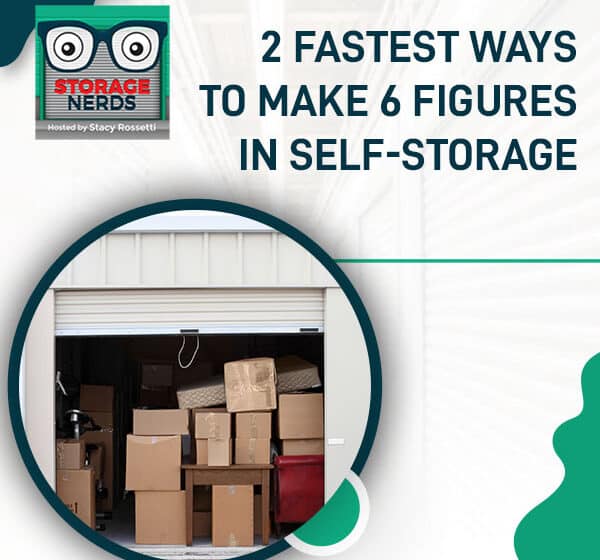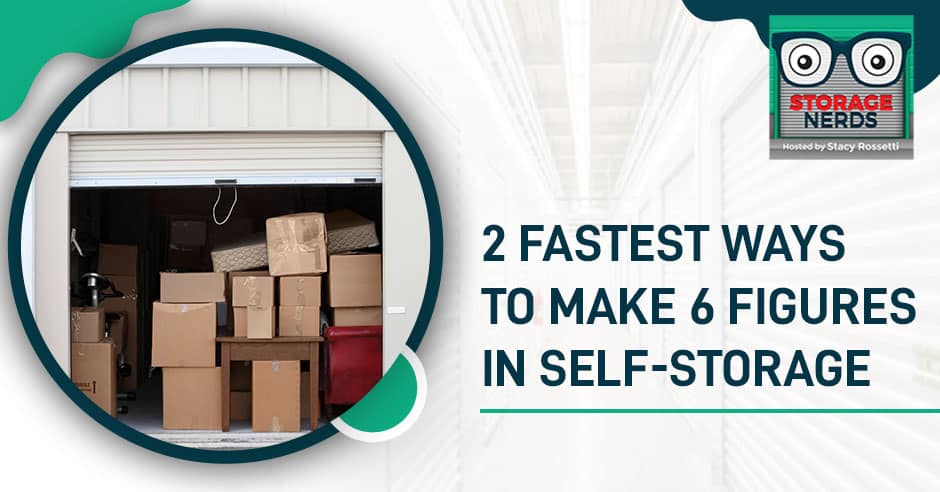
Is making six figures your goal? What is the fastest way to make it? The Storage Nerds has a treat for you in this episode! Stacy Rosetti shares the two fastest ways to make six figures in self-storage. She discusses that one of the fastest ways to make the most money is by mismanaged facilities. Stacy also gives an in-depth discussion on wholesaling self-storage facilities. Tune in to this episode and make that six figures in self-storage!
—
Watch the episode here
Listen to the podcast here
2 Fastest Ways To Make 6 Figures In Self-Storage
For everybody that doesn’t know me, I teach how to get started in self-storage investing. If you are wondering what is going on with the world, the United States, “Where should I put my money? What should I be doing to protect myself over the next couple of years while we have a downturn,” all these types of thoughts that pretty much everybody has in their mind, especially me, I’m having these as well too, I want to say that you are in the right spot because self-storage and investing in self-storage is one of the best places that you could be investing.
It’s very stabilized. We’ve got price increases and decreases. I’ve noticed that the prices of facilities are going down. Tell me what you are seeing in the market if you’ve been out there but there are a lot of storage facilities for sale. I’ve never seen so many facilities on Crexi or LoopNet. I do not buy facilities on Crexi or LoopNet.
In this episode, we are going to be talking about the two fastest ways for you to make money in self-storage investing. One of the ways that we’re going to be talking about is going directly to the owner. If you follow me, all of the thirteen facilities that we own, because we closed on a facility, are direct to the owner. Where you’re going to make the most amount of money is by going directly.
I’ve seen some students listing properties that started with me in my coaching. I started in 2019 and then they’re selling them now. They bought facilities in 2019, 2020, 2021 and 2022. They’ve had 2 or 3 years. They’ve listed their properties for sale because they’ve stabilized the properties and stuff but they listed the properties for too much. I told them they were too high.
For any property, if you want to sell it quickly, then you should be 20% under the market. That’s my opinion. What do you think about this? Do you want to sell a property? We’re going to be selling a few of our storage facilities. My husband Pete is the person that manages all of our facilities. He has been working on getting all of our facilities up, cleaned up and looking good so we can sell them.
If you want to be selling your properties, you should be at 20% below what everybody else is. If you can’t sell your properties at 20% below what everybody else is, then it’s not the right time to sell. You should hold onto your properties. That’s my opinion. We are going to be selling a couple of our properties because we want to be able to 1031 exchange those for something bigger when better deals come on the market.

I set it up on Crexi. Any storage facility that comes on the market, I want it to be emailed to me as soon as it comes onto the market so I could see what it looks like. I’ve never bought anything off Crexi but I want to know what’s coming on the market and what’s for sale. What Crexi do, if you haven’t signed up for them yet, is they’ll email you on a daily or weekly basis to see all the facilities that are coming on the market. I do it weekly. I highly recommend that you do that as well too. I do it nationwide. I want to know every storage facility that’s for sale.
We can get into Crexi so I can show you what it looks like. I have access as an investor. They have investor software that you can get into. Let’s go for sale. If you go to Crexi and sign up, it’ll look a little bit different because I have an investor account within. I paid for that. If anybody’s interested in getting the investor account, then email me and let us know at Questions@StacyRossetti.com. We can introduce you to Grant, who is my Account Specialist. He can hook you up with the Stacy Special because if you don’t go through mine, it’s going to be more expensive.
All I’m doing is getting into Crexi and looking up for sale. Six hundred and sixty-two storage facilities are for sale in the entire country. I’ve never seen this many storage facilities for sale. It was always up until 300, maybe 400 but never 600 or 700 units. Can you guess how many storage facilities are there in the country? “Why do you think there are many for sale?” A good question from Joe. People are freaking out.
They’re thinking exactly the way I am, “Why am I going to sell my facilities?” I want some cash to be able to buy some bigger facilities. I started with little tiny facilities, 100 units and I’m slowly moving into bigger facilities, anywhere between $1 million and $3 million. I also purchased these types of facilities for the fund. I need some cash to be able to do that. I’m selling some of my facilities.
The purpose of this episode is to talk about the two fastest ways for you to make money in self-storage. One of them is going to the owner and purchasing directly from the owner so that you can get the best deals. The only way that you can list on Crexi is through a realtor and then you have a realtor that you have to pay as well, all the fees and everything. It adds up. You don’t have to do that if you go directly to the owner. A lot of times the owners don’t know what their property is worth.
More times than not, the owners do not know what their property is worth. As a person or investor, it’s your job to educate the owners on what their properties are worth. You give them an offer. We do that through our magic letter. To make the most money, going directly to the owner is going to be the best way. We all know that. We’re all learning how to do that. That’s why you’re here. That’s how I bought all my facilities. We go directly to the owner.
Making the most money directly to the owner is the best way.
The facility that we closed on is in Macon, Georgia, a medium-sized town. It’s a secondary market. It’s like an industrial rental kind of town. Do you have these in your states where it’s very industrious and houses are affordable? That’s how Macon is. There is about 150,00 population. I’ll share with you how we’re going to make money on this facility. One of the fastest ways is to go directly to the owner, ask the owner if they’re interested in selling and then educate the owner.
It’s your job as the investor to educate the owner on what their property is worth and you do that by using the magic letter. If you don’t know yet, it is giving the owner several different offers. Sometimes a cash offer, owner financing offers or bank financing offer. It’s funny because we had a lender that came on to our mastermind. He was telling us a couple of other ways too, which I thought were great ways and I was like, “I need to add these to the magic letter.”
He’s a lender that mostly does storage. He said what he was seeing were two different things. One of them was called lease to own. Storage facility owners could lease their storage facility out to somebody else that they wanted to sell it and then they lease it for a couple of years, maybe 1 or 2 years for the buyer, for you as the buyer to be able to purchase the facility, run it, manage it and then run it for a couple of years and then decide if you want to buy it.
That’s a very good strategy for you to do something like this if it’s a mismanaged facility and it’s not worth what the owner wants to sell it for, then what you could do is work out with the owner that you can do what’s called lease to own, which I thought was a very good and cool strategy. It’s owner financing but it is not owner financing. You’re not changing the deed over. Rent to own is what it is. I thought that was good. I’m already going to implement that in the magic letter. If I come up with properties, I could say, “Here’s another option for you.”
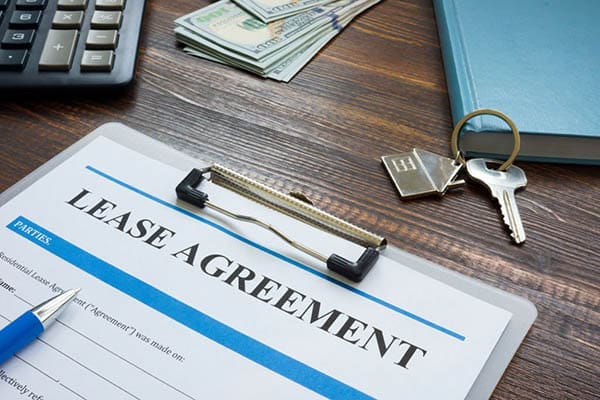
I’ll get more into these. I’ll teach this more once I do these strategies a little bit better. The other one that he said was, “The owner can do seller financing in a second.” What would happen is that you go to the lender and the lender says, “I’m only going to give you X amount of dollars. You have this thing.” I have a property that I probably could have used this for and I didn’t even think about this.
I had a property under contract for $1.5 million. I went to the bank and the bank told me that the property was only worth $1.2 million. They would finance $1.2 million but not the $1.5 million. Essentially, what we could have done is we could have got a bank loan for the $1.2 million and then the other $200,000 or $300,000 on the back end, then you can have a second from the owner for that 2, 3 or whatever amount of money it is but a couple hundred thousand dollars.
That was another thing that the lender brought up, which I thought was very good. It’s funny because I was talking to an owner the other day and he said, “I want to have X amount of dollars for the property.” It’s not worth that much. I said, “The bank is only going to finance $800,000 and you want $1.2 million. The issue is the bank isn’t going to finance but if you’re open to it, what if I got a bank to give me the loan for the $800,000? You come in and finance on with a second on the other part of it? Would you be open to that?” He said, “I would be open to that.”
I learned about that, then I talked to an owner and brought it up. He said, “I’d do that.” I was like, “That’s such a good strategy.” We’re also going to add that to the magic letter too, which is funny because then I talked to another guy that hired me as a consultant to run some numbers on a deal. He had put an offer in for a property. It was $2.5 million. He needs $250,000 for the down payment. He asked the owner if the owner would owner finance the down payment for him. The owner said yes, which is another strategy that would be awesome.
If you can’t afford the down payment, why don’t you ask the owner to owner finance the down payment if it’s super big? I was talking to a student and she brought that up. She says, “I don’t know if I’m going to be able to afford all of the down payment. Do you think that the owner would owner finance it?” I said, “Yes. That is a great strategy and you should ask the owner.” My point is that over the course of the next couple of years, as more and more of these facilities come on the market, I want you to start broadening your horizons on how you’re going to be able to fund these because we all know that banks are becoming more conservative.
We are running our numbers at 25% down and 7% interest. If we were going to even finance a loan, we don’t know where that interest rate is going to be in 90 days or 120 days. They could easily raise rates until March 2023 because this is what Jerome Powell is saying. They could keep raising the rates and then hold them stable for one year. Honestly, something like that is going to happen.
We need to be running our numbers at what we’re going to be paying interest in the time that we’re going to be closing that. I keep telling my students and my virtual assistant, “This is how we’re doing it. This is how we’re running numbers.” You can go and get an SBA loan. Everybody thinks that you could put 10% down for SBA but in the end, I would calculate 15% because I’ve seen a lot of students getting SBA loans and they always say 10%, then 1 or 2 weeks before closing, they come back and say 15%.
Especially if you’re a newbie, because the lender that came in and talked to us at the mastermind said, “Newbies are not going to do 10%. They’ll do 15%.” If you’re going to do an SBA loan, you run your numbers to 10% or 15% based on the experience that you have but still, the interest rate is prime plus 1. We’ve seen prime plus 2 and prime plus 3 depending on your experience with SBA. You want to be careful of that. You go to a conventional bank. It’s 25% down and 7% interest. You want to be leery about the financing that’s coming up.
Going on to Crexi and finding deals, especially if they’re running them high, you want to be running your numbers at the correct number for the closing table. One of the fastest ways for you to make money in self-storage, in my opinion, is going directly to the owner and then giving the owner lots of options. I’m going to be talking about creative deal structuring more because this is what’s going to start happening. I started in real estate in 2010. For five years, I did rehabs and then I got pregnant with Lillian. That’s when I moved over to storage because I wanted to stay home with her and be with her.

That was in 2010, 2011 and 2013. I don’t know if anybody has been investing in real estate for that long but in 2010, 2011 and 2012, there were not a lot of lenders out there. They had all gone bust. There were not a lot of banks that were lending but there were a lot of hard money lenders. It was crazy percentages like 15 and 5 points. I had to learn how to be creative. I’m blessed for going through that time because of two things that I learned during that timeframe as an investor, one of them was how to raise money, which is something that you’re going to have to be focusing and I will be focusing on this for everybody.
How are we going to raise money? How are we going to finance these things? What kind of creative deal structuring can we do to close the deals? When you talk to your lender, like we had coffee, come on and talk to us, if they’re like, “I’m 25% down and 7% interest,” then you need to look for more lenders to be working with because when you only work with a lender that only has one type of term, that’s the only term that they know but if you go and find some broker that’s like, “We’re going to figure out how to get this deal done,” those are the best lenders to work with.
From 2010 to 2013, I learned how to be creative and make a lot of offers to owners. I want to be repetitive of that. We’ll be talking about not only making cash offers but owner financing offers, bank financing and creative deal structures like lease-to-own and owner carrybacks. Those are going to be some good structures that everybody will be able to learn.
The other thing is what I got good at. It is raising money. I have no qualms at all with asking people for money because I had to close on this storage facility and I was like, “Who has $50,000?” I’m emailing everybody I knew and asking them for $50,000. It seems like a good amount of money for people. They’re like, “I can do $50,000.” When you start asking for $100,000 or $200,000, they’re like, “I have to look into this and analyze it.” Keep that in mind. $50,000 is magical with private money.
I learned how to raise money. Raising money means asking people, whether or not they want to lend you money or partner with you. We’ll get into that as well because it’s going to be super important for you to learn how to raise money. Commercial real estate is expensive. You could do one deal and that’s it because you don’t know how to raise money. The truth is things are getting more expensive.
It’s going to be super important for you to learn how to raise money.
Steve asks, “How many lenders can be part of one deal?” You can’t put a whole bunch of non-accredited investors together. The SCC does not like this at all but you can put a couple of people together that know and trust you. You can’t go ask strangers for money but you can ask people that know, trust and like you.
A couple of them is good but not a lot. For instance, if you could put 3 or 4 people that have $50,000. that’s a $200,000 down. I’m partnering with the students. There are four of us in that deal. We all gave a little bit different amounts of money but we partnered and then created a company. It was a $3 million property. That company had a down payment enough to make a $3 million property.
Somebody’s asking, “This is my first time with this. What’s the cash on cash we usually get on storage?” We shoot for 10% cash on cash. That’s cash if you pay cash and you’ll get more money if you go to a bank. If you leverage your money, then you want more money. We shoot for 10% or higher. When we run our numbers on our deal analyzer, the buffer is 10%. We want more money than that.
Income-producing properties, a lot of time is 10%. It is a good number for an income-producing property. You maybe raise the rates a little bit and then over time, you’re building a little bit of appreciation. This is the least risky type of deal. It’s an income-producing property that makes 10% or 12% cash on cash return. It’s a good buy-and-hold. I buy mismanaged facilities and severely depleted horrible facilities. Why? Because the cash-on-cash return is going to be way better than that.
That’s where you have to come out of pocket every single month. Ten percent cash on cash return for an income-producing property is good. Mismanaged facilities. We want way better cash on cash return. I’ll give you an example. I’ll show you the one that we closed. This is going into my fund because I love sharing the wealth with all my investors.
The topic is what’s the fastest way to make money in self-storage. Mismanaged facilities are going to be one of the fastest ways to make a lot of money in self-storage. It’s a lot more work though. The question is, how much work and effort do you want to put into the bill?
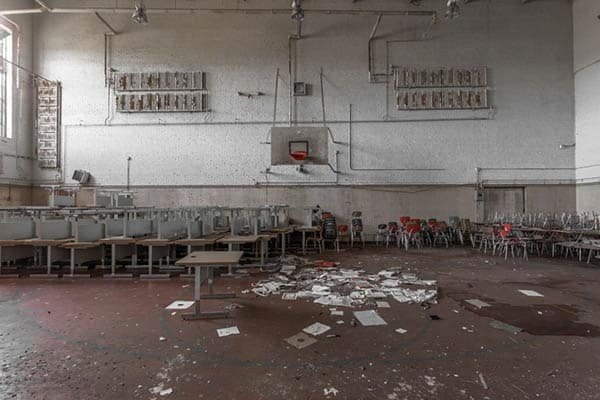
You mentioned the quickest way to make the most amount of money was on the buy. We had an infield training day and we were going over a couple of properties we had in Florida. Everyone’s always astounded at how cheap Stacy picks up these properties because it’s a mismanaged issue. We can get them up to value quickly. She negotiates pretty hard. She’s getting what she does. She’s a smooth talker.
I’m going to show them Max to give them an idea.
On the buy is where you make your money. She triples the value in under a year by managing it correctly. That’s all I wanted to say.
Max is the one that we closed on. This is what it looks like. This is in blue. Back here was not painted blue. This big building is a big warehouse that somebody could be renting out but it’s filled with crap and stuff. These two buildings back here were never painted. He started painting it and he loves his sign. He worked hard on this sign right here. What we do is buy the ugliest storage facilities in town.
This facility is right here. You could see there’s a long building right here. This is a big building. Here’s another building. There are 7 or 8 buildings. It’s on 6 acres. All back here is included. We could make another entrance if we wanted to. This is a huge, big property, 6 acres. This property right here is for sale for $1.7 million. I don’t know how many units it is but the owner told me that it’s only 10 feet. This one is 15 feet. It’s squished together a little bit.
We got lots of room in ours. This is one parcel of land. This parcel right here is also included. That’s what it looks like. Let me pull up the deal analyzer and then we’ll look at the number so I can show you what I’m talking about. This facility is 171 units but he only has 92 units that worked. In the other less than 80 units, the doors are broken and something is going on with that unit.
It’s 171 units, 20,000 square feet and he’s only making $14,000 a year. He’s making $1,000 a month. The 92 units are at $14,635. We added $200,000 in CapEx. If you run the numbers, it’s not worth anything. Typically I buy my facilities at negative 2% caps all the time. My facility is always at super low cap rates and negative cap rates because what that means is that the company’s not making any money. He has 92 units that he could rent out and he is only making $14,000.
This is what I consider a very severely mismanaged facility. It needs a lot of work, new doors and cleaning up. It’s going to take us 18 to 24 months to clean this thing up and start making some money on it. This is where I tell my investors but once we get it cleaned up, just 171 units are worth $2 million. Once we get the 171 units filled up, we will cap them.
On top of that, it’s got all 6 acres. Both of them are 3-acre-lot. It’s got the warehouse as well too that we can clean up. It’s got a whole huge big space that you could do parking as well. This whole area in the front is this massive, huge space that you could do parking, also there could be parking down here in the back as well. If you wanted to add on and clear up this area, you could do that. There are lots of opportunities in this deal but it’s severely mismanaged.
Anybody can buy this deal. It’s only all in of $550,000. It’s not a very big, large deal but $550,000 for 171 units is a very good price. In 18 months, we’ll make $1.5 million and decide what we want to do. Do we want to refi out, leverage that money and go buy another facility or do we want to pay all the investors back and then everybody can reap the reward? Somebody is asking about the cap rate. We’re running the cap rate at a 7% cap because it’s Macon.
Macon has 150,000 people in it. It’s not a 6% or 8% cap. It’s going to be somewhere around a 7% cap and it is a very fair cap rate to be running numbers ads. You know that when you buy a facility like this, it’s going to take a lot of work and effort. Your risk level essentially is a different type of risk level. You have income-producing properties. A lot of people want to buy income-producing properties.
They don’t want to do their work. They just want to make cashflow and a little bit of appreciation on the back end. There’s nothing wrong with those and those are everywhere. The type of facilities that we buy is the ugliest facility in town. What my husband does is stabilize those properties. On every single property, all twelve of the other ones that we’ve bought. We have 2 in the fund and then the 11 that we own are all exactly like this. We can take the property and double, triple or quadruple the value of the property in 18 to 24 months.
That is the fastest way to make money in the purchase. Lisa says, “Why would you not buy high cashflowing property?” We like the bigger appreciation on the back end. We want to make $1 million on the back end when we sell it. In some facilities, you can do that. If I can get their cashflowing property, one of the deals that we have in the fund, we bought it for $2 million or $3 million and it’s making $100,000 a year. That’s a cashflowing property that we’ll be able to make money on the back end. Those are out there as well too.
That would be considered a mismanaged facility because it was supposed to be making $20,000 to $25,000 a month and it’s only making $10,000 a month. The owner of that facility was charging $20 for a 10×10 and we raise the rate to $100 because that’s what the market rate goes for. If you can find those, it’s awesome as well. It’s your risk level. Tyler is saying, “Are there key indicators that show a facility is severely mismanaged?”
I went over the deal. How much money is it making versus what the average price per square foot is and could be? That’s the key. Keep that in mind. What’s the average price per square foot? What is it making now? What could it be making? For instance, on the one that we have on Max, it’s $0.66 a square foot. It should be at $0.78 a square foot. There are 3 or 4 competitors in the area. My husband went over there and checked out the facility. He went to every single competitor in the area and a couple of the facilities and said, “I’d be interested in renting a unit out.”
Some of them have offices and stuff the same size. They all have offices when you walk in. Everybody was at between $0.85 to $0.90 a square foot as our competitors. We decided to be at $0.78 a square foot because we wanted to be more competitive. We ran our numbers at $0.78 a square foot. You can see the price difference. Doing the competitive analysis is important so you could see what you could do.

Everybody’s asking about the magic letter and the deal analyzer. It is only offered to my students and my coaching program. I may change that in the future, I’m not sure but for now, that’s it. The Super Simple Self-Storage Course does have a deal analyzer in it. It’s almost exactly like this one, except for this one has a couple more tabs on it. This one you can do owner financing on and the other one you cannot. All my coaching students used the other deal analyzer. I haven’t quite released this to the public yet.
I’m having all my virtual assistants use this deal analyzer. My students use this deal analyzer and maybe later I might release it to the public but I want to make sure everything’s perfect first. You have to hang on. Get the deal or the course and you will have the deal analyzer in there. It doesn’t have the owner financing section in it.
The second fastest way to make money and self-storage investing. The first way is, in the buy, like Pete says and then mismanaged facilities versus income-producing properties. The second way is whole-selling self-storage. That’s where it’s at. I had one of my students come into the mastermind and he started a few years ago with me. He’s wholesale seventeen storage facilities and bought several himself.
Wholesaling The Property
His strategy is, “If they will owner finance, I will purchase the property myself. If they don’t owner finance, then I’m going to wholesale the property,” which is a very good strategy. For a lot of you, especially if you don’t have any money and you’re like, “I don’t know if I can do this if Stacy says everything’s expensive,” which is true, it is expensive, then what you can do is wholesale self-storage.
In my course, we have a whole section on wholesaling self-storage. Essentially what that means is that you are the middle person between the buyer and the seller. You go out and talk to owners like we talked about at the beginning of the session and get the owner to put the facility under contract for whatever price that you get. It could be owner financed, lease to own, the owner carrying a second bag, cash, bank financing or whatever the owner wants to do. You can wholesale any facility that has any strategy at all because everybody will do all the strategies.
Everybody will buy something even with the strategy on that. The thing with wholesaling in the real estate world is, “You have to make a cash offer.” That’s not true. You have to make offers because it’s a numbers game anyways. You want to make offers. You want to give the owner lots of options. Nobody ever makes me offers. We got thirteen facilities. We never get any offers at all. We’ve done $60 million worth of offers. Every offer that we send out has at least four different offers, if not more.
A lot of times the owner is like, “I never got an offer letter like that before. It’s always one offer or cash offer.” You need to learn how to wholesale. You go to the owner. You put the facility under contract with your offer and then you go out into the world. You need to put it under contract and pay the earnest money. You have $100,000. Don’t even put that much money down, just $1,000 at the most. Sometimes if it’s a huge, big facility, they want a more down payment.
I’ve never put anything more than $1,000 down. In the $1 million that we closed, I put $1,000 down. People think that you have to put in $5,000 or $10,000 and they’re like, “I don’t have enough money for the earnest money.” Put in $1,000. Every once in a while you’ll get an owner that’s like, “I need to see proof of funds. I’ll move on to the next person.” You’re going to put the facility under contract, go out and pay your earnest money so that you create what’s called equitable interest in the transaction.
As a wholesale, the only way that you can sell and market property is if it’s your own property. The only way that you can market as somebody else’s property is if you have equitable interest in that. As a realtor, you have them sign a contract and you have a license. You can go and do it. As a wholesaler, you have to have the property under contract. Once you get it under contract and you pay your earnest money, then you can go out to the world and try to find a buyer for that.
You can only market somebody else’s property if you have equitable interest.
You’ll mark that property up a little bit. Don’t be greedy. It’s annoying to me when wholesalers are greedy because what it does is screws up the whole deal and then you end up not selling it in the first place. If you can make $25,000 or $50,000, then you should be happy. You mark it up a little bit so that you can make some money on that deal and then sell it to the person that wants to buy it. They put it under contract and purchased it. I do this all the time with my students. We have several under contract because we have what’s called turnkey acquisitions.
My virtual assistant will go out and find property for my students. That’s one of the programs that we offer. My virtual assistant will put offers in and then finally somebody will accept an offer. I’ll put it under contract. I’ll pay the earnest money and then we’ll go out. We’ll find one of our students to buy the deal and then they’ll be able to buy it. We do that quite often. It’s called wholesaling. In some states, it’s illegal to wholesale. I can’t remember which one it is.
You can wholesale mismanaged facilities or income-producing properties. Lisa asked, “Do you wholesale mismanaged facilities?” You can wholesale any type of property. It doesn’t matter what it is, land, storage or commercial retail houses. You can wholesale it as long as it’s legal in your state and you understand the laws that fall within your state because every state’s a little bit different.
You can make a little bit of money on the back end. Especially for people that don’t have a lot of money and say, “I want to get into storage but I don’t know how to,” wholesale some facilities. Get out there, find the deal, make lots of offers because it’s a numbers game and then get one under contract. There are a couple of different ways for you to find buyers. You can post it in Facebook groups. You want to start building a buyer’s list so that when you do have a deal, then essentially you reach out to them and say, “I have this deal. Would you be interested in that?”
You could always come to me if you want because I have a list of 30,000 people and they’re all interested in storage. We could always partner and I could help you to find the buyer or you can get out there and network. Go to your stat state’s like Self-Storage Association Conferences. Let everybody get out there, network and know the area like, “I’m a wholesaler in your state. What are you looking for? I’ll get out there and find something for you.”
You’ll get it under contract from the seller with the buyer and make that spread in the middle of $25,000 or $50,000. I have a student whom I closed on a deal and he paid $100,000 to the wholesaler for finding that down. It was a $1.6 million deal. He’s okay with that because, in the end, it was going to be worth $3 million or something. People that know what they’re doing don’t care how much money you’re going to be making on the wholesale side. We’re in the process of buying a $2.5 million facility and the wholesaler’s going to make $200,000 or something.
People who know what they're doing don't care how much money you're going to be making on the wholesale side. Share on X
Mismanaged Facilities
If you don’t have money or you think that this is your mojo, we have a couple of students in the group that’s what they do. They’ve been wholesaling on the residential side and they’re doing storage. One of the fastest ways to make money is to learn how to wholesale self-storage. In the course, there’s a whole section on wholesaling. If you do decide to join the coaching program, the door is open in January 2023, I can be there to hold your hand. A lot of people say, “I need somebody to help.” That could be what I could do.
Wendy says, “Indiana and Illinois.” It was some of the states. I can’t remember which ones. Maybe Google, “Which states are wholesaling illegal?” You can see if it’s in your state or not. I’m going to be getting onto the pitch, which is StacyRossetti.com/Fund. This is where I’m going to be pitching my Self-Storage Fund of America. This is where I raise money, go out and buy deals like this Max deal. Max is a 33% IRR. We’re going to go over the pitch. If you’re an accredited investor, make sure you come to hang out with me on the pitch.
Wendy says she has the course and she’s going through it. You do have the deal analyzer in the course. Go to the deal analyzer video. All the templates in the course are underneath that course. For instance, there’s a due diligence video that I go over due diligence and then you’ll have a little due diligence checklist. The deal analyzer video and then you’ll have the deal analyzer right there.
All your templates should be right underneath those videos, for everybody that has the course or is interested. Ariel posted $1,000 off the course. If you’re interested, click on that and then you can start going through the course. It takes many videos. Go in your time to read as you go through. I have not added the magic letter yet to the course but I will be adding that. We’ve been updating the course as we update all the videos and stuff. We added all my case studies in there, replays, a whole bunch of new videos and stuff. The deal analyzer and all kinds of stuff are in there. You’ll get all those updates.
We have Todd saying, “How many days of due diligence do you ask for when you’re wholesaling?” We do 60 days of due diligence and then 120 days of close. Another thing that we do is ask for a 72-day financing contingency. It’s 60 days of due diligence, 72 days of financial contingency and then closes in either 90 or 120 days. We try to push for 120 days but if we don’t, then we’ll do it to 90 days.
“Why should we go with cap rate or price per square foot when buying the property?” Storage is honestly about the price per square foot. A lot of people in the commercial world think about what’s the cap rate but the truth of the matter is what’s the price per square foot now and what can you take it to? It’s what you should be looking at. Another thing that you should be looking at is demographics. Is it a growing economy? Is it stable? You don’t want something that’s going down. People are leaving.
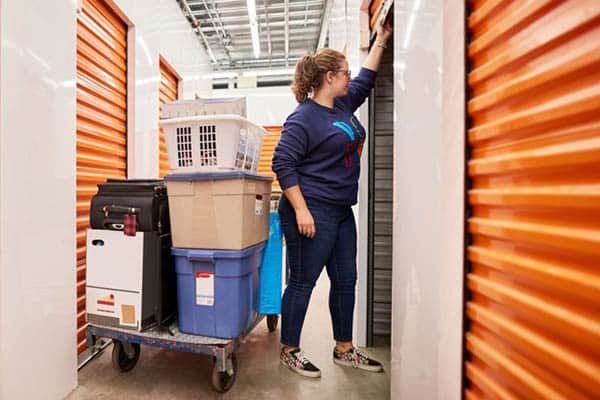
I tell my VA’s negative 1% plus because like a lot of economies, honestly, over the past few years, the growth and stuff are screwed up because they moved out and then went back. Negative 1% in the last few years but it’s been growing or something. You want a growing or stable economy within that area that you are in. We’ve been looking at that quite a lot lately.
“How do your property and pricing compare to the ones for the sale near your new units?” I’m not quite sure what you mean by that but we do an out in-depth competitive analysis. We look at every facility that’s near us. We look at what they’re charging versus what we’re charging and then we take the average of all those and use that average as the number of the value add that we can get to.
Someone is asking about the fund and the $50,000. You could start a company if you said, “Give me $50,000.” You have three 3 or 4 people and that’s $200,000. You would create a company and each of you would be divided based on how much you could put into that company. That would be your equity split. One of you would be the boots-on-the-ground person or the asset manager where you’d have to come up with that operating agreement that shows what everybody’s going to be responsible for. I appreciate everybody reading. Take care. Bye.
Important Links
- Crexi
- LoopNet
- Questions@StacyRossetti.com
- Super Simple Self-Storage Course
- StacyRossetti.com/Fund
- Self-Storage Fund of America

